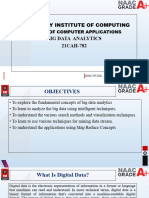0% found this document useful (0 votes)
13 views15 pages08 Big Data Introduction
Big Data refers to large and complex datasets characterized by volume, velocity, and variety, which traditional tools struggle to manage. It includes structured, semi-structured, and unstructured data, with technologies like Hadoop and Spark facilitating analysis. Big Data is crucial for evidence-based decision-making, customer insights, and operational efficiency, despite challenges such as data quality and security.
Uploaded by
ilalarukh21Copyright
© © All Rights Reserved
We take content rights seriously. If you suspect this is your content, claim it here.
Available Formats
Download as PDF, TXT or read online on Scribd
0% found this document useful (0 votes)
13 views15 pages08 Big Data Introduction
Big Data refers to large and complex datasets characterized by volume, velocity, and variety, which traditional tools struggle to manage. It includes structured, semi-structured, and unstructured data, with technologies like Hadoop and Spark facilitating analysis. Big Data is crucial for evidence-based decision-making, customer insights, and operational efficiency, despite challenges such as data quality and security.
Uploaded by
ilalarukh21Copyright
© © All Rights Reserved
We take content rights seriously. If you suspect this is your content, claim it here.
Available Formats
Download as PDF, TXT or read online on Scribd
/ 15























































































